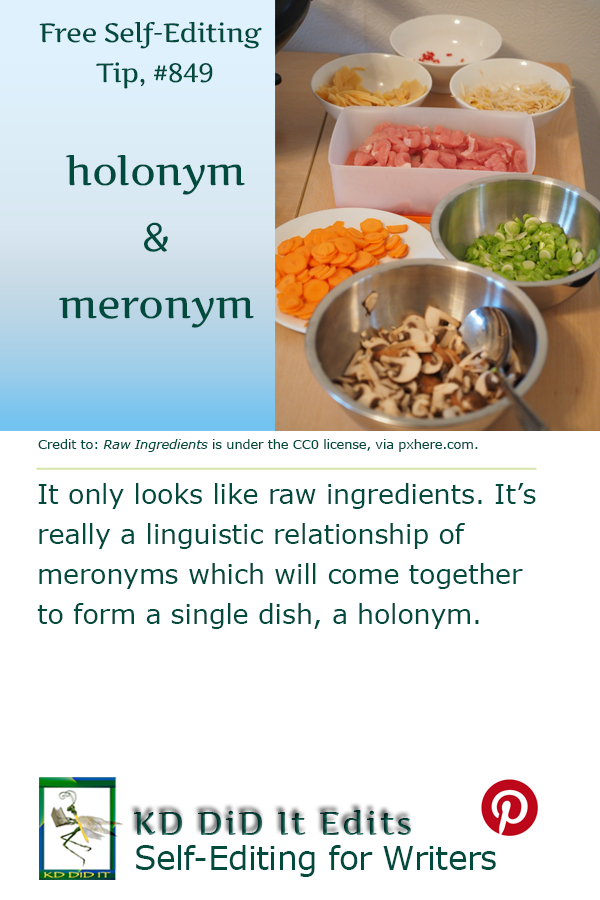Revised as of
8 March 2021
A meronym is a part of something that is whole, a holonym. Consider a tree (the holonym). It’s made up of parts (meronyms): bark, leaf, branch.
This makes it a relationship between elements of material objects.
You may also want to explore the post on “Hypernyms and Hyponyms“, which also use relationships but they are conceptual.
Linguistics is . . .
. . . the systematic study of the nature, structure, and variation of language (of which grammar is a part), which describes how people use language. For the writer, how words are used (or spelled!) determines a character’s social and educational level and the time period for the story.
As I discover more examples, also-known-ases, and additions, I’ll update this post. If you have a suggestion, I would appreciate you contacting me. If you found this post on “Holonyms and Meronyms” interesting, consider subscribing to KD Did It, if you’d like to track this post for future updates.
| Holonym | ||||||||||||||||||||||||||||||||
| Part of Speech: Linguistics; Semantics | ||||||||||||||||||||||||||||||||
| Definition: Constitutes the name of the whole in a whole-to-part relationship. | ||||||||||||||||||||||||||||||||
|
Return to top or post contents |
Examples | |||||||||||||||||||||||||||||||
|
||||||||||||||||||||||||||||||||
| Meronym | Definition: Part of a holonym, it denotes a part of something and can refer to the whole of it.
A meronym may have a relationship to another meronym. |
|||||||||||||||||||||||||||||||
|
Return to top or post contents |
There is a controversy over what constitutes “type” of a meronym. Lyons and Cruse claim there are two types: necessary, a.k.a., canonical, and optional, a.k.a., facilitative.
Orwant prefers to divide meronyms into part, member, and substance. A.k.a. partonomy |
|||||||||||||||||||||||||||||||
| Necessary or Optional Examples: | ||||||||||||||||||||||||||||||||
|
||||||||||||||||||||||||||||||||
| Part/Member/Substance Examples: | ||||||||||||||||||||||||||||||||
Credit to: Orant |
||||||||||||||||||||||||||||||||
| Co-meronym | Definition: Technical term for a meronym that has a relationship to another meronym — a sister meronym, which shares the same relational criteria.
Credit to: Murphy |
|||||||||||||||||||||||||||||||
|
||||||||||||||||||||||||||||||||
C’mon, get it out of your system, bitch, whine, moan . . . which words are your pet peeves? Also, please note that I try to be as accurate as I can, but mistakes happen or I miss something. Email me if you find errors, so I can fix them . . . and we’ll all benefit!
Satisfy your curiosity about other Linguistics posts by exploring its homepage or more generally explore the index of self-editing posts. You may also want to explore Book Layout & Formatting Ideas, Formatting Tips, Grammar Explanations, the Properly Punctuated, Word Confusions, Writing Ideas and Resources, and Working Your Website.
Resources for Holonyms and Meronyms
Allan, Keith. Concise Encyclopedia of Semantics. Elsevier, 2009.
Cruse, Alan D. Lexical Semantics. Cambridge: Cambridge University Press, 1986.
Kuzmenka, Nastassia. “Meronymic Structures fro Names Denoting Parts of Living Beings in English.” Minsk State Linguistic University. n.d. Web. 18 February 2020. <https://repozytorium.uwb.edu.pl/jspui/bitstream/11320/4680/1/BAJ_15_Kuzmenka.pdf>.
Lyons, John. Semantics. Cambridge: Cambridge University Press, 1977.
Murphy, M. Lynne. Semantic Relations and the Lexicon: Antonymy, Synonymy and Other Paradigms. Cambridge University Press, 2003
Nordquist, Richard. “Definition and Examples of Meronyms and Holonyms.” ThoughtCo.com. 3 July 2019. Web. 18 February 2020. <https://www.thoughtco.com/what-is-a-meronym-1691308>.
Orwant, Jon. Games, Diversions, and Perl Culture. O’Reilly & Associates, 2003.
Pinterest Photo Credits:
Raw Ingredients is under the CC0 license, via pxhere.com.


